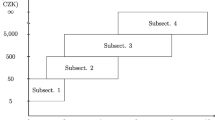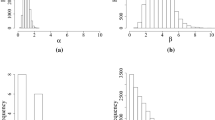Abstract
How should sentencing disparity be assessed when decisions are constrained under a sentencing guidelines system? Much of the debate over the measurement of sentence disparity under a guidelines system has focused primarily on using specific values from within the sentencing grid (e.g., minimum recommended sentence) or on using interaction terms in regression models to capture the non-additive effects of offense severity and prior record on length of sentence. In this paper, I propose an alternative method for assessing sentencing disparity that uses quantile regression models. These models offer several advantages over traditional OLS analyses (and related linear models) of sentence length, by allowing for an examination of the effects of case and offender characteristics across the full distribution of sentence lengths for a given sample of offenders. The analysis of the distribution of sentence lengths with quantile regression models allows for an examination of questions such as: Do offender characteristics, such as race or offense severity, have the same effect on sentence length for the 10% of offenders who receive the shortest sentences as they do for the 10% of offenders who receive the longest sentences? I illustrate the application and interpretation of these models using 1998 sentencing data from Pennsylvania. Key findings show that the effects of case and offender characteristics are variable across the distribution of sentence lengths, meaning that traditional linear models assuming a constant effect fail to capture important differences in how case and offender characteristics affect punishment decisions. I discuss the implications of these findings for understanding sentencing disparitites, as well as other possible applications of quantile regression models in the study of crime and the criminal justice system.











Similar content being viewed by others
Notes
Similarly, a small but growing body of research has shown the effects of case and offender characteristics to differentially affect the jail v. prison decision (see, e.g., Holleran and Spohn 2004).
Boot camp incarceration is also an option for the sentencing judge, but since a boot camp incarceration would not typically be included in an analysis of sentence length decisions, it is excluded from the range of sentence lengths noted here.
Bushway and Piehl (2001) noted a similar issue in their analysis of data from Maryland.
A quantile refers to a percentile in the distribution of a variable. For example, a quantile of 0.70 would refer to the same point in a distribution as the 70th percentile.
This is a situation most sentencing researchers are also confronted with: Those offenders who are not incarcerated are effectively a “0” on the dependent variable and then excluded from the analysis. Quantile regression techniques could be used to address this concern without relying on various sample selection models that may be more or less appropriate for the analysis of sentencing decisions (Bushway et al. 2007).
For a comprehensive discussion of the construction and interpretation of boxplots, see Tukey (1977).
The choice of data set was somewhat arbitrary. My goal was to illustrate the application and the interpretation of quantile regression models with data that had been analyzed in other published studies. Hopefully, interested readers would then make comparisons between the results reported here and those in other published works using the same or similar data.
The quantreg library (Koenker 2008), a component of the R system (R Development Core Team 2003), was used to estimate all quantile regression models. Readers interested in testing quantile regresison models for their research questions may also estimate these models in Stata and SAS. Stata’s version 10.0 (Stata Corporation 2007) includes quantile regression procedures that allow for the estimation of individual quantiles or a range of quantiles. SAS’s version 9.1 includes an experimental quantile regression procedure (PROC QUANTREG) that can be downloaded from the SAS web site (http://www.sas.com). PROC QUANTREG (updated in January 2009) also estimates individual quantiles as well as a range of quantiles. By using the ODS feature in SAS, it is possible to plot the quantile regression process in a manner consistent with the results displayed in Figs. 8 and 9 in this paper. However, at the time of this writing, neither Stata’s nor SAS’s quantile regression procedures allow for testing the location and location-scale hypotheses.
All of the coefficients noted as not statistically significant have p > 0.10.
Basic collinearity diagnostics did not indicate any problems with the inclusion of this set of case and offender characteristics.
To the extent that there are minor differences between the results reported here and those published in prior research using the Pennsylvania data, the differences are due to the large number of cases with very short sentences (i.e., less than one month) that were excluded from the analyses reported here.
A reviewer raised a concern about collinearity diagnostics for the quantile regression results. At this point, there are no unique ways of testing for collinearity in a multivariate quantile regression model. An indicator that collinearity is likely not a problem is reflected by the pattern of most case and offender characteristics remaining statistically significant across the range of quantiles.
In much of the literature on quantile regression coefficients, the full range of effects plotted in these figures is referred to as the quantile regression process.
Ulmer and Bradley’s (2006) analysis of Pennsylvania sentencing data included interaction effects for their jury trial variable with offense severity, prior record score, rape conviction offense, robbery conviction offense, and offender’s race (black). Although their inclusion of an interaction effect was a positive step forward in the analysis of the “trial penalty,” it still falls to the criticisms noted above regarding fixed effects of the independent variables across the distribution of sentence lengths.
References
Buchinsky M (1994) Changes in the U.S. wage structure 1963–1987: application of quantile regression. Econometrica 62:405–458
Buchinsky M (1998) The dynamics of changes in the female wage distribution in the USA: a quantile regression approach. J Appl Econom 13:1–30
Bushway SD, Piehl AM (2001) Judging judicial discretion: legal factors and racial discrimination in sentencing. Law Soc Rev 35:733–764
Bushway S, Johnson BD, Slocum LA (2007) Is the magic still there? The use of the Heckman two-step correction for selection bias in criminology. J Quant Criminol 23:151–178
Conley T, Galenson D (1998) Nativity and wealth in mid-nineteenth-century cities. J Econ History 58:468–493
Durose MR, Langan PA (2007) Felony sentences in state courts, 2004. USGPO, Washington, DC
Eide ER, Showalter MH (1999) Factors affecting the transmission of earnings across generations: a quantile regression approach. J Hum Resour 34:253–267
Eide ER, Showalter MH, Sims DP (2002) The effects of secondary school quality on the distribution of earnings. Contemp Econ Policy 20:160–170
Engen RL, Gainey RR (2000a) Modeling the effects of legally relevant and extralegal factors under sentencing guidelines: the rules have changed. Criminology 38:1207–1230
Engen RL, Gainey RR (2000b) Conceptualizing legally relevant factors under guidelines: a reply to Ulmer. Criminology 38:1245–1252
Fox J (2008) Applied regression analysis and generalized linear models, 2nd edn. Sage, Los Angeles
Gilchrist WG (2000) Statistical modelling with quantile functions. Chapman and Hall, Boca Raton, FL
Handcock MS, Morris M (1999) Relative distribution methods in the social sciences. Springer, New York
Hao L, Naiman DQ (2007) Quantile regression. Sage, Thousand Oaks, CA
Holleran D, Spohn C (2004) On the use of the total incarceration variable in sentencing research. Criminology 42:211–240
Johnson BD (2005) Contextual disparities in guidelines departures: courtroom social contexts, guidelines compliance, and extralegal disparities in criminal sentencing. Criminology 43:761–796
Johnson BD (2006) The multilevel context of criminal sentencing: integrating judge- and county-level influences. Criminology 44:259–298
Koenker R (2005) Quantile regression. Cambridge University Press, New York
Koenker R (2008) Quantile regression in R: a vignette. http://www.econ.uiuc.edu/∼roger/research/rq/vig.pdf
Koenker R, Bassett G (1978) Regression quantiles. Econometrica 46:33–50
Koenker R, Bassett G (1982) Robust tests for heteroskedasticity based on regression quantiles. Econometrica 50:43–61
Koenker R, Hallock KF (2001) Quantile regression. J Econ Perspect 15:143–156
Koenker R, Xiao Z (2002a) Inference on the quantile regression process. Econometrica 70:1583–1612
Koenker R, Xiao Z (2002b) Inference on the quantile regression process: electronic appendix. http://www.econ.uiuc.edu/∼roger/research/inference
McCullagh P, Nelder J (1989) Generalized linear models, 2nd edn. Chapman and Hall, New York
Mello M, Perrelli R (2003) Growth equations: a quantile regression exploration. Quart Rev Econ Financ 43:643–667
Miethe TD, Moore CA (1986) Racial differences in criminal processing: the consequences of model selection on conclusions about differential treatment. Sociol Quart 27:217–237
Miller PW (2005) The role of gender among low-paid and high-paid workers. Aust Econ Rev 38:405–417
Mora MT, Davila A (2006) Hispanic ethnicity, gender, and the change in the LEP-earnings penalty in the united states during the 1990s. Soc Sci Quart 87:1295–1318
Mustard DB (2001) Racial, ethic, and gender disparities in sentencing: evidence from the U.S. federal courts. J Law Econ XLIV:285–314
Ostrom BJ, Ostrom CW Jr, Hanson RA, Kleiman M (2007) Trial courts as organizations. Temple University Press, Phildelphia, PA
Powell JL (1984) Least absolute deviation estimation for the censored regression model. J Econom 25:303–325
Powell JL (1986) Censored regression quantiles. J Econom 32:143–155
R Development Core Team (2003) R: a language and environment for statistical computing. http://www.R-project.org
Rossi PH, Berk RA (1997) Just punishments: federal guidelines and public views compared. De Gruyter, New York
Spohn C, Cederblom J (1991) Race and disparities in sentencing: a test of the liberation hypothesis. Justice Quart 8:305–327
Stata Corporation (2007) Base reference manual. Stata Press, College Station, TX
Steen S, Engen RL, Gainey RR (2005) Images of danger and culpability: racial stereotyping, case processing, and criminal sentencing. Criminology 43:435–468
Tonry M (1996) Malign neglect: race, crime, and punishment in America. Oxford University Press, New York
Tukey JW (1977) Exploratory data analysis. Addison-Wesley, Reading, MA
Ulmer JT (1997) Social worlds of sentencing: court communities under sentencing guidelines. SUNY Press, Albany, NY
Ulmer JT (2000) The rules have changed—so proceed with caution: a comment on Engen and Gainey’s method for modeling sentencing outcomes under guidelines. Criminology 38:1231–1244
Ulmer JT, Bradley MS (2006) Variation in trial penalties among serious violent offenses. Criminology 44:631–670
Ulmer JT, Johnson B (2004) Sentencing in context: a multilevel analysis. Criminology 42:137–177
Ulmer JT, Kurlychek MC, Kramer JH (2007) Prosecutorial discretion and the imposition of mandatory minimum sentences. J Res Crime Delinq 44:427–458
Walker TR (2000) Economic opportunity on the urban frontier: wealth and nativity in early San Francisco. Explor Econ Hist 37:258–277
Wheeler S, Weisburd D, Bode N (1982) Sentencing the white-collar offender: rhetoric and reality. Am Sociol Rev 47:641–659
Author information
Authors and Affiliations
Corresponding author
Rights and permissions
About this article
Cite this article
Britt, C.L. Modeling the Distribution of Sentence Length Decisions Under a Guidelines System: An Application of Quantile Regression Models. J Quant Criminol 25, 341–370 (2009). https://doi.org/10.1007/s10940-009-9066-x
Received:
Accepted:
Published:
Issue Date:
DOI: https://doi.org/10.1007/s10940-009-9066-x




